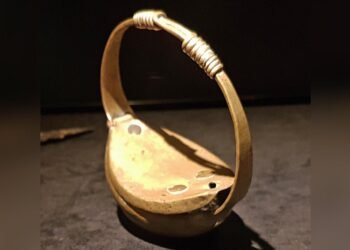One of the most fascinating discoveries in northwestern Iran is providing a glimpse into the personal grooming habits of Iron Age elites.

Researchers analyzed a sample of kohl, a traditional eye makeup used throughout the ancient Middle East, from an Iron Age burial site at Kani Koter in Iran’s Kurdistan Province. The cemetery, dating back to the 9th to 7th centuries BCE, was on the eastern edge of the Assyrian Empire and provided artifacts linked to high-status members of society, including weapons, jewelry, horse equipment, and personal grooming items.
Among the items found was a ceramic container with a powdery black substance that drew special interest. Scientists used advanced laboratory techniques to examine its contents in hopes of uncovering the materials used in this ancient cosmetic. What they discovered, as published in the journal Archaeometry, was a blend of minerals previously unknown in kohl recipes: a combination of manganese oxides and natural graphite.
Kohl has a long and extensive history throughout the ancient world, particularly in Egypt, where it was used both for aesthetic and medicinal purposes. Traditional recipes were often based on lead-based ingredients, which are known to impart a deep black hue. The Kani Koter sample is exceptional for not using lead entirely. Instead, the black color was achieved from pyrolusite, a manganese-rich mineral, and shiny, flaky graphite, a carbon-based substance that is now universally found in modern pencils but was extremely rare in ancient cosmetics.

This combination is significant. Not only is it the first known use of graphite in kohl, but it also suggests local adaptation. The researchers speculate that this combination of minerals would have been chosen for both appearance and availability. The Zagros Mountains, close to Kani Koter, have both manganese and graphite, so Iron Age artisans were working with local natural resources.
Functionally, the addition of graphite would have given the makeup a visual appeal. Its reflective quality provides a metallic shimmer, and its layered structure allows it to adhere well to the skin—a beautiful combination for eye makeup.
There were no organic compounds like plant oils or animal fat in the sample. While it might be possible that the makeup was constructed solely of inorganic materials, scientists also suggest that organic material could have existed originally but later degraded over the centuries.

The cosmetic container itself was found in an elite burial that included silver jewelry, a bronze mirror, and ivory applicators. The context of this, along with the care that was put into the formulation of the kohl, illustrates the cultural importance of appearance among Iron Age elites, regardless of gender. In fact, art from the Assyrian period shows both men and women wearing eye makeup, and the application of kohl may have had aesthetic, symbolic, and possibly even medicinal uses.
Unlike other sites across ancient Iran and Mesopotamia, the Kani Koter find adds to a growing body of evidence of regional cosmetic traditions. While the majority of recipes for kohl at this time involved lead-based compounds, the use of manganese and graphite suggests an unrecorded variant—one that was tailored to regional tastes, resources, and perhaps even fashion trends.
The researchers wrote in their paper that “kohl” recipes are markedly different at each site. A further Iron Age kohl sample from Hasanlu represents yet another recipe, despite being geographically very close to Kani Koter in the northern parts of the Iranian Zagros Mountains.
This discovery deepens our knowledge of the Iron Age tradition of grooming and reveals how ancient people expressed identity, beauty, and status—through the shine of graphite and the black of manganese around the eyes.

























Comments 0